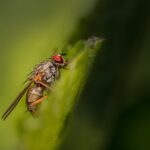Honeybees have long fascinated researchers due to their complex social structures and remarkable navigational abilities. These tiny creatures, vital to ecosystems and agriculture, utilize a sophisticated array of behaviours to locate food sources and return to their hives. Over the past century, numerous studies have contributed to our understanding of honeybee navigation, revealing that it relies on multiple sensory modalities, including visual, olfactory, and temporal cues. Pioneering scientists such as Karl von Frisch, Nikolaas Tinbergen, and Joseph Banks Rhine laid the groundwork for our current understanding through groundbreaking experiments that highlighted how bees communicate and navigate their environments.
Karl von Frisch’s exploration of the waggle dance in the 1940s and 1950s, particularly in his 1967 book *The Dance Language and Orientation of Bees*, provided insights into how bees convey information about the direction and distance of food sources to their hive mates. Similarly, Bergen’s landmark experiments in the 1930s and 1940s established the significance of visual landmarks in helping bees orient themselves in their surroundings, as documented in his 1932 paper Über die Orientierung des Bienen und Grabwespen. These foundational studies not only expanded our knowledge of honeybee behaviour but also underscored the importance of interdisciplinary research in unravelling the complexities of animal navigation.
As the body of research grew, scientists began to uncover the multifaceted nature of bee navigation, integrating findings related to colour vision in the 1910s, olfactory cues in the 1930s, and even the influence of temporal factors on foraging behaviour in the 1970s. The exploration of these various aspects has illustrated that honeybees are not merely instinctual creatures, but rather exhibit a level of cognitive complexity that allows them to adapt to their ever-changing environments. This essay will delve into the key studies that have shaped our understanding of honeybee navigation, emphasizing the intricate behaviours and sensory mechanisms that enable these remarkable insects to thrive in their ecological niches.
Lubbock’s Light Sensitivity Experiments (1880s)
Sir John Lubbock, an early naturalist, conducted experiments to examine bees’ sensitivity to light and how this influenced their navigation. He used different intensities of light and darkened conditions to test whether bees could navigate without sunlight. He observed that bees were less active under lower light levels, but still managed to navigate in dim conditions. This suggested that bees have highly sensitive light perception, allowing them to detect changes in light conditions while flying.
Reference:
Lubbock, J. (1882). Ants, Bees, and Wasps: A Record of Observations on the Habits of the Social Hymenoptera.
Baer’s Hive Relocation Experiment (1900s)
Karl Baer investigated how bees respond when their hive is moved to a different location. Baer relocated a beehive and observed the bees’ initial confusion as they returned to the original site. Over time, the bees adapted and successfully relocated their hive. This provided further evidence of bees’ ability to memorize visual landmarks.
Reference:
Baer, K. E. (1901). Observations on the Navigation of Honeybees.
Fabre’s Orientation and Memory Experiments (1900s)
The French entomologist Jean-Henri Fabre observed bees’ ability to return to their hive and food locations using landmarks. Fabre conducted simple relocation experiments by moving a bee’s hive to a new position and observing their behaviour. The bees initially returned to the old site, suggesting they memorize specific landmarks. He demonstrated that bees rely heavily on visual memory and cannot instantly adjust to changes in their environment.
Reference:
Fabre, J. H. (1915). The Life of the Fly.

Charles Turner’s Colour Vision Experiments (1910s)
Charles Turner, one of the earliest African-American scientists studying animal behaviour, conducted experiments to understand whether bees could differentiate between colours. Turner placed coloured cards in different locations and trained bees to associate a specific color with food. He found that bees could indeed distinguish between colours and preferred certain colours to others. This was one of the first demonstrations that bees have colour vision and use it in navigation.
Reference:
Turner, C. H. (1910). “Experiments on Colour Vision in the Honeybee.” Biological Bulletin.
von Frisch’s Sugar Water Experiments (1920s)
Before discovering the waggle dance, Karl von Frisch demonstrated that bees have the ability to remember the location of food sources over long distances. He trained bees to visit specific locations by placing sugar water there. Bees would continue to return to that spot even when the food was removed. This early experiment showed that bees could memorize the spatial coordinates of food sources.
Reference:
von Frisch, K. (1927). “Über den Sitz des Geruchssinnes bei der Honigbiene.” Zeitschrift für vergleichende Physiologie.
Joseph Banks Rhine’s Odor Experiments (1930s)
Joseph Rhine’s experiments focused on the role of scent in bee navigation. His findings showed that bees could associate particular odors with food sources, demonstrating that olfactory cues play an important part in their homing ability.
Reference:
Rhine, J. B. (1937). “Further Experiments on the Role of Odor in Honeybee Orientation.” Journal of Comparative Psychology, 23(4), 409-420.
Rhine, J. B. (1931). “A Preliminary Study of the Role of Odor in the Orientation of Honeybees.” Journal of Comparative Psychology, 12(2), 137-160.
Max von Laue’s Compass Orientation Experiment (1933)
Max von Laue, a Nobel Prize-winning physicist, investigated whether bees used the Earth’s magnetic field for navigation.
Experiment: Laue placed magnets around a hive to see if bees’ navigation was affected. He found that magnetic fields had little effect on their ability to return to the hive.
Result: This suggested that magnetic fields were not a significant factor in bee navigation.
Reference: von Laue, M. (1933). “Der Einfluss des Magnetfeldes auf die Orientierung der Honigbiene.” Naturwissenschaften.
Adrian Wenner’s Scent Marking Hypothesis (1960s)
Adrian Wenner proposed that bees use scent marking to navigate, contrary to von Frisch’s waggle dance theory. Wenner placed hives in new locations and altered the scent trails bees left behind. He argued that bees relied more on olfactory cues rather than visual communication through the waggle dance. Though the waggle dance was widely accepted, Wenner’s work highlighted the importance of scent in short-distance navigation.
Reference:
Wenner, A. M. (1967). “The Behaviour of Honey Bees in the Vicinity of the Hive.” Journal of Comparative Physiology.
Tinbergen’s Landmark Experiments (1930s-1940s)
Nikolaas Tinbergen demonstrated how bees use visual landmarks for navigation. His work with visual cues and landmarks confirmed the role of environmental features in helping bees find their way back to the hive.
Reference:
Tinbergen, N. (1951). The Study of Instinct. Oxford University Press. (Chapter on bee orientation and behavior).
Tinbergen, N. (1932). “Über die Orientierung des Bienen und Grabwespen.” Zeitschrift für vergleichende Physiologie, 16, 305-334.
Karl von Frisch’s Honeybee Dance Language (1940s-1960s)
This book details Karl von Frisch’s extensive studies on the waggle dance of honeybees, explaining how bees use this dance to convey information about the direction and distance of food sources. It provides experimental evidence on how bees adjust their dances based on the movement of the sun and other environmental cues.
Reference:
von Frisch, K. (1946). “Die Tänze der Bienen.” Österreichische Zoologische Zeitschrift, 1, 1-48.
von Frisch, K. (1967). The Dance Language and Orientation of Bees. Cambridge: Harvard University Press.
Barker and Margaria’s Speed and Distance Perception (1950s)
D. J. Barker and R. Margaria conducted early work on how bees estimate distance during flight. Using controlled flights in corridors with visual patterns, the researchers tested whether bees could estimate how far they had travelled based on the visual motion of the patterns. Their findings helped establish that bees use optic flow to gauge distance travelled.
Reference:
Barker, D. J., & Margaria, R. (1954). “Visual Control of Flight Speed in Honey Bees.” Journal of Experimental Biology.
Heinrich’s Time-Memory Experiments (1970s)
Bernd Heinrich investigated the temporal aspects of bee navigation, exploring how long bees can remember the location of food sources. Heinrich trained bees to visit a feeding site at specific times of day by providing sugar water. He discovered that bees remembered not just the location, but also the time of day they had found food. This showed that bees have an internal time sense linked to their foraging activity.
Reference:
Heinrich, B. (1976). “The Foraging Specializations of Individual Bumblebees.” Ecological Monographs.
Srinivasan’s Visual Navigation (1990s)
While more modern, Mandyam Srinivasan contributed significantly to understanding how bees use visual cues to navigate through cluttered environments. Srinivasan placed bees in tunnels with various visual textures on the walls. He demonstrated that bees use the movement of images across their retinas (optical flow) to judge speed and avoid obstacles. This was a key finding in understanding how bees navigate in complex environments using their visual system.
Reference:
Srinivasan, M. V. (1991). “Honeybee Navigation: Nature and Calibration of the Odometer.” Science.








